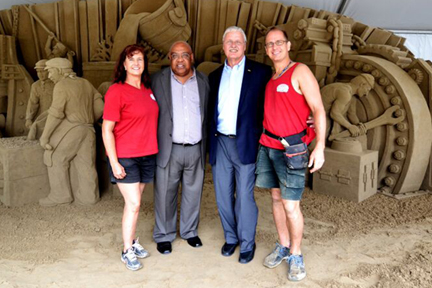Each year, the Regatta features a sand sculpture at Point State Park in downtown Pittsburgh and this year, the sculpture allows viewers to reflect on Pittsburgh’s most prominent historical era – the old steel industry.

The sculpture features a 13-foot backdrop of vertical, fanning eyebeams and several life-sized sculptures of steelworkers doing general factory maintenance and pouring steel into molds. Using sand and water, the sculptors created realistic depictions of workers’ bulging, muscular arms, rolled sleeves, oversized gloves and utility overalls.
Jill Harris, founder of Sandsational Sand Sculpting, spent months researching the visual aspects of the steel industry and decided to depict a scene including procedures from the early 1900s-1930s before safety regulations were implemented.
“With the safety gear, there’s not a lot of shape to it,” Harris said. “If you look back at the old pictures, there’s no safety gear. They have a cap and goggles and maybe some gloves, an apron and that’s it. That’s the period we’re going to take because then I can show arms and show people moving.”
 United Steelworkers International Secretary-Treasurer Stan Johnson said the scene and what it symbolizes is not only visually breath-taking but also says a lot of our union.
United Steelworkers International Secretary-Treasurer Stan Johnson said the scene and what it symbolizes is not only visually breath-taking but also says a lot of our union.
“The sculpture is an amazing piece of art that not only reflects an important part of Pittsburgh’s history, but also symbolizes so much about our union’s history and our role in the steel industry. The sculpture depicts a time when safety was not a top priority of companies, and we’ve come so far - in large part because of the work our union has done and continues to do. We now have safer work places, better equipment and procedures and laws that better protect our members and our communities rom workplace accidents,” Johnson said.
This is Sandsational’s fifth year sculpting for the Regatta. In previous years, the sculptors did American art icons, the signing of the Declaration of Independence, America’s pioneering spirit and the Battle of Fort McKenry.
This year’s sculpture features 150 tons of sand and is completed in two weeks with four total sculptors, all of whom are independent artists from all across America. The sand is sourced locally from Georgetown Sand and Gravel, and Neville Aggregates.
The company spends two days compacting sand using a jumping jack compactor, which holds the sand together. The sculpture starts as a block of compacted sand that is then sculpted from the top, working down.
“We bought a bunch of books to research and it’s incredible to see – it’s the middle of the day, but it still looks black as night from all the pollution – and look at the city now,” Harris said. “You’ve got all this beautiful green space, and steel…is still a very important part of the city.”
Harris noted that during the two-week sculpting process, passersby mentioned relatives who used to work in the old steel mills and stressed the importance of heritage and pride with this year’s theme.
“What an incredibly rich history. This city is steel,” Harris said.
USW International President Leo Gerard agreed.
“Pittsburgh is known as the Steel City and we’re proud to call the city the home of our union,” Gerard said. “As this incredible sand sculpture suggests, steel making and all manufacturing was and remains a huge part of our community’s identity and of our nation’s economy. The times may be different and the way we make steel may have evolved, but what hasn’t changed is the fact that a strong manufacturing base is instrumental to the success of cities like Pittsburgh and to our entire nation.”
